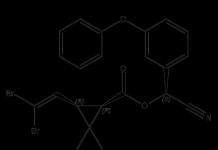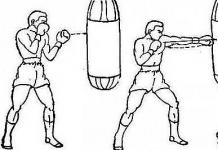Goal of the work. Learn to determine the oxidizability of water by the permanganate method and carry out the primary processing of the results.
Reagents and solutions.
1. 0,01 N KMnO 4 solution (it is better to prepare from fixanals, in the absence of the latter, take a sample equal to the molecular weight of KMnO 4 divided by 5 and 100, i.e. 158 / (5100) \u003d 0.316 g, and dissolve in a volumetric flask by 1 l; the titer of the solution is unstable; with each determination of oxidizability, it is set anew).
Exactly 0.01 N oxalic acid solution H 2 C 2 O 4 2H 2 O (prepared from fixanals).
25% sulfuric acid solution (by volume).
Crockery and equipment.
1. 300 ml conical flasks - according to the number of samples.
Glass capillaries or beads are placed at the bottom of the sample flask prior to oxidation to ensure uniform boiling of the liquid in the flask.
Titration burette 25 ml.
Pipettes: 5 ml for 25% sulfuric acid solution, 10 ml for oxalic acid solution.
Graduated cylinder or 100 ml pipette for measuring the required sample volume.
Electric stove or gas burner.
General information. Organic substances are always present in water in the form of suspensions, colloidal or molecular compounds. At present, there is no sufficiently reliable method that allows one to completely isolate organic matter from water and quantify it, therefore, indirect methods are more often used to judge the content of this substance in natural waters. The most common estimate of the amount of organic matter is based on the oxidizability of water. Under oxidizability understand the amount of oxygen consumed for the oxidation of organic matter (under certain conditions) contained in 1 liter of water.
Depending on the oxidizing agent used, permanganate (KMnO 4 oxidizer) and chromate or dichromate (K 2 Cr 2 O 7 oxidizer in sulfuric acid) oxidizability are distinguished.
The permanganate method for determining oxidizability is the most widely used, especially in fish farming, because of its simplicity, the bichromate method requires more time and labor. Comparing the values of bichromate and permanganate oxidizability, one can judge the quantitative composition of organic matter in water.
Definition principle. Oxidation is carried out by boiling the test water for exactly 10 minutes with a solution of potassium permanganate added to the sample. During boiling, atomic oxygen is released from KMnO 4 and easily oxidized organic substances are oxidized by this oxygen. This process can take place in both acidic and alkaline environments. Usually, in fresh waters, oxidation is carried out in an acidic environment, in sea waters - in an alkaline one.
2KMpO 4 + ZN 2 SO 4 \u003d K 2 SO 4 + 2MnSO 4 + ZN 2 O + 5O (19)
For better oxidation, it is necessary to add a solution of potassium permanganate to the sample in excess, i.e., so that after boiling the sample remains colored pink. If, upon boiling with KMnO 4, the color of the sample becomes brownish, the oxidation should be repeated from the beginning, diluting the test water by 2.5 or 10 times. Permanganate that has not gone into the oxidation of organic matter is reduced with a solution of oxalic acid added to the sample in an amount equivalent to the amount of potassium permanganate solution poured into the water sample before boiling it.
2KMnO 4 + 5C 2 H 2 O 4 + 3H 2 SO 4 - K 2 SO 4 + 2MnSO 4 + 10CO 2 + 8H 2 O (20)
The amount of oxalic acid remaining in the sample, after reducing the excess of KMnO 4, is titrated with a solution of potassium permanganate. By the amount of potassium permanganate solution used for titration, the value of water oxidizability is judged, and 1 ml is 0.01 N KMnO 4 solution is equivalent to 0.08 mg of atomic oxygen used for the oxidation of organic matter in the sample.
Definition progress. Take 100 ml of the test water into a conical flask, add 5 ml of a 25% sulfuric acid solution and heat to boiling. At the very beginning of boiling, 10 ml of 0.01 N KMnO 4 solution and then boil the sample for exactly 10 minutes (it is desirable to time the time by a clock with a second hand or a stopwatch). It is necessary to ensure that the boil is uniform and not very violent. For this purpose, before heating the flask with the sample, glass beads or capillaries well washed with distilled water and dried are placed at the bottom of this flask.
If a brown tint appears during the boiling process, the sample should be treated as indicated in the principle of determining oxidizability by this method.
At the end of boiling, 10 ml of 0.01 N oxalic acid solution, mix its contents and titrate the discolored liquid 0.01 N KMnO 4 solution until a stable faint pink color appears.
Determination of the correction factor to the titer of the KM solutionno 4 . To determine the correction factor for the normality of the KMnO 4 solution, 10 ml of exactly 0.01 N oxalic acid solution and titrate 0.01 N potassium permanganate solution.
The correction factor is calculated by the formula: K=10/n (*), where P - the amount of ml of potassium permanganate solution used for titration 10 ml exactly 0.01 N oxalic acid solution.
Calculation of results. In the process of determining, records should be kept in a table (see Table 3) (Appendix).
The value of oxidizability is calculated by the formula:
O = mg/l, (21)
where A 1 - the amount of KMnO 4 solution added to the sample at the beginning of boiling ml; A 2 - the amount of KMnO 4 solution used for sample titration, ml; K - correction factor to the titer of potassium permanganate solution; B - quantity exactly 0.01 N oxalic acid solution added to the sample after its oxidation, ml; 0.08 - the amount of oxygen equivalent to 1 ml 0.01 N KMnO 4 , ml; V is the volume of the sample taken for analysis, ml.
The calculation results should be rounded up to 0.01 mg/l.
The order of the work. They study the principle of determining the permanganate oxidizability of water in the laboratory. Determine the permanganate oxidizability of water. Prepare a report.
Report.
CONTROL QUESTIONS
What is water oxidizability?
Name the methods for determining oxidizability. What are their advantages and disadvantages?
What is the unit for oxidation?
What is the principle of determining oxidizability by the permanganate method?
What is the relationship between the amount of KMnO 4 solution used for sample titration and the value of oxidizability?
What should be done if in the process of boiling a sample with a solution of potassium permanganate (during oxidation) the solution turned brown in the flask? What does this indicate?
LAB #7
DETERMINATION OF WATER HARDNESS
Goal of the work. Learn to determine the hardness of water and carry out the primary processing of the results.
Reagentsand solutions.
1.0,02 N a solution of Trilon B (disubstituted sodium salt of tetrabasic ethylenediaminetetraacetic acid) is prepared from fixanals. In the absence of fixanals, 3.72 g of this salt (Na 2 H 2 C 10 H 12 O 8 N 2 2H 2 O) is taken and dissolved in a 1 liter volumetric flask, gradually bringing the total volume of the solution to the mark.
Buffer solution (dissolve 20 g of NH 4 Cl in distilled water, add 100 ml of concentrated ammonia solution and bring the total volume to 1 l with distilled water).
Indicator solution (chromgen black) (0.5 g of El-00 indicator is dissolved in 10 ml of buffer solution and the volume is adjusted to 100 ml with ethyl alcohol).
4. Exactly 0.02 N magnesium sulfate (MgSO 4 7H 2 O) it is desirable to prepare from fixanal. Dishes.
1. 300 ml conical flasks - according to the number of samples plus one.
Pipettes: 5 ml for buffer solution; 25 ml or 10 ml to measure the required sample volume (if it is less than 50 ml); per 10 ml for a solution of MgSO 4.
Dropper for black chrogen.
Measuring cylinder 100 ml.
General information. General hardness natural water shows the content in it of cations of divalent alkaline earth metals and, above all, calcium and magnesium. These elements enter the water during the dissolution of carbonates or as a result of biochemical processes occurring in the upper layers of the soil cover. The hardness of fresh water varies widely. Particularly soft is the swamp water and the water of ponds, filled mainly with precipitation (1-2 ° Hem). Hardness of 20°Hem and above is typical for groundwater and for rivers, ponds and lakes located on soils with easily leached Ca and Mg salts, especially if the waters of these reservoirs are rich in CO 2, which contributes to the dissolution of carbonates.
In some southern regions there are lakes, the water hardness of which reaches 100 ° Hm and above.
The amount of calcium and magnesium equivalent to the amount of carbonates and bicarbonates in water is called carbonate hardness. Non-carbonate hardness- the difference between the total and carbonate hardness - shows the amount of alkaline earth metal cations corresponding to the anions of mineral acids: chloride, sulfate, nitrate ions, etc.
For fish ponds, too soft water with low alkalinity is undesirable. To meet the needs of aquatic organisms in Ca and Mg, water is needed, the alkalinity of which is not lower than 2 mg / l and the hardness is about 5 ° Nem.
Definition principle. One of the most common methods is the trilonometric determination of total hardness with the chromogen black indicator. A certain amount of the indicator solution is introduced into the sample, having previously brought the reaction of the medium to pH 10 with an ammonia buffer. In this case, the indicator complexes with Ca 2+ and Mg 2+ cations are formed, and calcium first enters the compound as more active, then magnesium:
Na 2 Hind + Ca 2+  CaHInd + 2Na +
CaHInd + 2Na +  (22)
(22)
Na 2 HInd + Mg 2+  MgHInd + 2Na + (23)
MgHInd + 2Na + (23)
The magnesium complex with the indicator has a wine-red color, as a result of which, after adding the indicator, the entire solution turns wine-red, and then the test liquid is titrated with a solution of Trilon B. There is a transition of calcium and magnesium cations from complexes with an indicator to a complex with Trilon B, since Ca 2+ and Mg 2+ - complexes with the indicator are more dissociated than the complexes of these cations with Trilon:
CaHInd + Na 2 H 2 (tril.) \u003d CaH 2 (tril.) + Na 2 HJnd; (24)
MgHInd + Na 2 H 2 (tril.) = MgH 2 (tril.) + Na 2 HJnd. (25)
As a result of this transition, the indicator is restored, and the titrated solution changes color to blue at the equivalent point, since the black chromogen has a different color at different pH values.
pH 6.3 pH 11.5
NaH 2 Jnd  Na 2 HJnd
Na 2 HJnd  Na 3 Jnd (26)
Na 3 Jnd (26)
Wine red Blue Yellowish gray
Definition progress. The amount of the sample is taken depending on the hardness value: if the hardness does not exceed 5 mmol/l, take 100 ml of water; if hardness is 5-10 mmol/l, take 50 ml; with a hardness value of 10-20 mmol/l, the volume of water for analysis is 25 ml and, finally, with a water hardness exceeding 20 mmol/l, the sample volume will be 10 ml. In all cases except the first, the total volume of the sample must be brought up to 100 ml with distilled water. When applying this method to determine hardness, it should be borne in mind that some metals, such as iron, aluminum, if their content in water exceeds 20 mg / l, and copper, if its content is more than 0.3 mg / l, interfere with the determination, creating a soft color transition at the end of the titration. To eliminate the influence of copper, 1 ml of a 2% solution of Na 2 S is added to water before determination. The sample is placed in a conical flask, 5 ml of a buffer solution and 10 drops of a black chromogen indicator solution are added and titrated with a solution of Trilon B until the wine-red color changes to blue. Titrate slowly, constantly stirring the contents of the flask in a circular motion. At the end of the titration, Trilon B solution is added dropwise with pauses of 10–15 s.
Determination of the correction factor for the normality of the Trilon B solution. In a conical flask take 10 ml exactly 0.02 N magnesium sulfate solution, bring the volume to 100 ml with distilled water, add 5 ml of a buffer solution, 10 drops of an indicator, and titrate with a solution of Trilon B until the red-violet color changes to blue. The correction factor for the normality of the solution is determined by the formula (*), in which P- amount of Trilon B solution used for titration 10 ml 0.02 N magnesium sulfate solution. The correction factor is calculated with an accuracy of 0.01.
Calculation of results. In the process of determining, records are kept in tabular form (according to the model of Table 1 (Appendix)).
The value of the total stiffness is calculated by the formula:
Sa 2+ +Mg 2+ = A N TO 1000/ V mmol/l, (27)
where A is the amount of Trilon B solution used for sample titration, ml; N - normality of Trilon B solution; TO - correction factor to normality of Trilon B solution; V – sample volume taken for analysis, ml.
The results obtained must be expressed in mmol/l and in German degrees. When expressing the total hardness in German degrees, it should be borne in mind that earlier, not metal cations, but their oxides were determined in water. In particular, when determining the hardness of water, the calcium content was calculated in terms of CaO, with 10 mg of CaO corresponding to one German degree. Hence, 1 mmol/l of hardness corresponds to 1 mmol CaO/10, i.e. (28 mg.1) / 10 mg = 2.8 ° German.
Results are rounded to the nearest 0.001 mmol/l and to the nearest 0.1 °Hm.
Report. The report on this laboratory work consists of an oral interview with the teacher. The measurement results are presented in the prescribed form.
CONTROL QUESTIONS
What is total water hardness?
What units express the value of the total hardness?
What is the principle of determining the total hardness of water by the trilonometric method?
How to determine the correction factor for the titer of Trilon B solution?
LAB #8
DETERMINATION OF CALCIUM CONTENT (Ca 2 *) AND MAGNESIUM(Mg 2+ ) INWATER
Goal of the work. Learn to determine the content of calcium (Ca 2+) and magnesium (Mg 2+) in water and carry out the primary processing of the results.
Reagents and solutions.
1. 0,02 N Trilon B solution (for preparation, see laboratory work No. 6).
2N NaOH solution (80 g of chemically pure NaOH is dissolved in 1 liter of distilled water).
The dry mixture of the indicator (0.5 g of murexide and 9.5 g of NaCl is carefully ground in a mortar and stored in a bottle with a ground stopper).
Dishes.
1. 300 ml conical flasks - but the number of samples plus one.
Pipettes: 2 ml for 2 N NaOH solution, 25 ml to measure the required sample volume if it is less than 50 ml.
Burette 25 ml.
Measuring cylinder 100 ml.
General information. The principle for determining the calcium content is the same as for the total hardness of water. The calcium content is determined by the volumetric trilonometric method. As an indicator, murexide (ammonium purpurate) is used, which, in combination with calcium, is colored bright red. The free form of the indicator in an alkaline medium has a violet color. The volume of the sample taken for analysis depends on the calcium content: 100 ml with a Ca 2+ content of 0.5 to 2.5 mmol/l, 50 ml with a Ca 2+ content of 2.5 to 5 mmol/l and 25 ml when the content of Ca 2+ is more than 5 mmol / l.
The concentration of Mg 2+ in water is calculated from the amount of calcium and the value of the total hardness.
Definition progress. The required amount of test water is measured into a conical flask and the volume is adjusted to 100 ml with distilled water, then 2 ml of 2 N NaOH solution and 30 mg dry indicator mixture. Titrate the sample with Trilon B solution until the bright red color changes to violet. During the titration, the liquid in the conical flask should be vigorously stirred.
calculationresults. Records are kept in tables according to the model of Table 1 (attached).
N(Ca 2+ ) = A H TO 1000/ Vmmol / l,(28)
Where A- the amount of Trilon B solution used for sample titration;
N - normality of Trilon B solution; K is the correction to the normality of trilon B;
V –
In addition to mmol/l, the content of Ca 2+ is expressed in mg/l, for this the result obtained by formula (25) should be multiplied by the value of 20.04 mg, which corresponds to 1 mmol (eq.) Ca 2+ . The accuracy of determining calcium in water by this method is ≈ 1%.
After determining the total hardness and Ca 2+ content in water, a simple calculation can determine the amount of magnesium present in it (Mg 2+). To do this, determine the content of Mg +2 in mmol/l as the difference between the total hardness, expressed in mmol/l, and the calcium content in mmol/l. Then express the content of Mg 2+ in mg/l, multiplying the previous result by 12.16.
Report. The report on this laboratory work consists of an oral interview with the teacher. The measurement results are presented in the prescribed form.
CONTROL QUESTIONS
1. Why is the presence of Ca 2+ in the water of fish ponds necessary?
What is the principle of determining Ca 2+ in water?
How to determine the amount of Mg 2+ contained in water?
What units express the amount of Ca 2+ and Mg 2+ in water?
LABORATORY WORK No. 9.
DETERMINATION OF THE CONTENT OF CHLORIDES IN WATER
Goal of the work. Learn to determine the content of chlorides in water and carry out the primary processing of the results.
Reagents and solutions.
1. Silver nitrate solution (AgNOz), 1 ml which precipitates 1 mg Сl¯. Take a sample of 4.791 g of crystalline silver nitrate and dissolve in a 1 liter volumetric flask of distilled water.
10% chloride-free potassium chromate solution. Take 100 g of K 2 CrO 4 and dissolve in a small amount of distilled water, then add a few drops of AgNO 3 until a reddish-brown precipitate appears. Allow the solution to settle, then filter and bring the volume to 1000 ml with distilled water.
Sodium chloride solution, 1 ml of which contains exactly 1 mg Cl -. Take a sample of 1.6486 g of chemically pure NaCl and dissolve with distilled water in a 1 liter volumetric flask.
Dishes.
1. 300 ml conical flasks - according to the number of samples plus one.
Pipettes: 10 ml for NaCl solution; per 1 ml graduated for a solution of K 2 CrO 4.
Measuring cylinder 100 ml.
General information. Chlorides are the main component of the salt composition of sea water. In land water bodies, their content is negligible, with the exception of some lakes located on saline soils or mainly fed by highly mineralized groundwater. Such reservoirs are found in some places in the southern territories of Ukraine and Russia and in Central Asia. The content of chlorides in these reservoirs reaches hundreds and even thousands of milligrams per 1 liter, although usually their amount in land waters does not exceed 100 mg/l. If the increased content of chlorides cannot be explained by hydrometeorological conditions, it serves as an indicator of extraneous pollution. In land water bodies, chlorides are determined to obtain the magnitude of mineralization and pollution; in the seas and oceans, the salinity of water is calculated from the amount of chlorides.
Definition principle. The determination of chlorides in fresh water by the argentometric method is based on the precipitation of chloride anions with a solution of silver nitrate during titration. Potassium chromate solution is used as an indicator. The chemical essence of what is happening can be represented by the reaction equation:
NaCl + AgNO 3 = AgCl↓ + NaNO 3. (29)
As soon as all chlorine anions are bound, the reaction will begin:
K 2 CrO 4 + 2AgNO 3 = Ag 2 CrO 4 + 2KNO 3. (30)
The formation of Ag 2 CrO 4 salt will be indicated by the change in the color of the solution from lemon yellow to reddish, which does not disappear when shaken.
The principle of determining the chlorine content and salinity of sea water is similar to the principle of determining chlorides in fresh water. However, there are many significant differences in the technique for determining the chlorine content of sea water from the technique for determining chlorides in fresh water bodies.
To determine the chlorine content, a solution of silver nitrate is prepared at such a concentration that the reading on the burette during titration of sea water approximately corresponds to the chlorine content. For example, for water with normal (35%) salinity, the chlorine content of which is 19.38% (sp. weight 1.02674), the concentration of silver nitrate will be:
(4.791151.02674) / 2 = 36.92 g/l,
where 4.791 is the amount of AgNO 3 that precipitates 1 g of chlorine, provided that 15 ml of sea water is taken for titration.
To prepare 1 liter of solution, take a sample of AgNO 3 in the amount of 3.71 g, taking into account the presence of impurities in the AgNO 3 salt, which is produced by the industry.
When determining the chlorine content of sea water, special burettes and pipettes are used. These burettes differ from the usual ones by the presence of devices for automatic filling and setting the solution at zero division. Each division of the burette has a volume of 2 ml, the whole division, in turn, is subdivided into 20 fractional divisions. This allows you to count during titration with an accuracy of 0.01 ml. Burettes are available in several types for the determination of different chlorine levels.
Pipettes are used automatic, of the same capacity - 15 ml. A 15 ml sample is placed in a special titration glass with a thick oval bottom with a capacity of about 300 ml. During titration, the sample is thoroughly mixed with a glass rod.
To check the titer of a solution of silver nitrate and determine the chlorine content in the test water, it is necessary to titrate a sample of sea water with an exactly known value of chlorine content (the so-called "normal" water) under the same conditions as the sample. Normal water is ocean water, the chlorine content of which is precisely determined and corresponds to the average salinity of the ocean (35%). Normal sea water is produced in glass sealed cans with a capacity of 250 ml, on the label of which the exact value of chlorine content is indicated.
Definition progress. Take 100 ml of the test water into a conical flask (if the water is more turbid, it is filtered), add 1 ml of a 10% solution of K 2 CrO4 and titrate with a solution of AgNO3 with constant stirring until a stable reddish tint appears. It is desirable to carry out titration with two "witnesses" (in one flask, a sample with K 2 CrO 4 only, in the other - a slightly overtitrated sample).
Determination of the correction to the titer of solution AgNO 3 . The correction to the AgNO3 titer is determined by the exact solution of NaCl, 1 ml of which contains 1 mg of Cl¯.
10 ml of NaCl solution is placed in a conical flask, the volume is adjusted to 50 ml with distilled water, 0.5 ml of a 10% solution of K 2 CrO 4 is added and titrated with a solution of silver nitrate until the color of the solution changes. The correction is determined by the formula (*), where n is the number of ml of AgNO 3 solution used for titration with 10 ml of NaCl solution.
Calculation of results. All entries during the performance of work are made in the table according to the model of Table 1 (Appendix).
C(Cl¯) = (A 1 TO 1000)/ V mg/l (31)
where A is the amount of AgNO 3 solution used for sample titration, ml;
1 - the amount of Cl¯, which precipitates 1 ml of AgNO 3 solution during titration;
TO- correction to the titer of AgNO 3 solution; V- the volume of the sample taken for analysis.
The results of titration when determining the chlorine content of sea water are calculated by the formula:
WITHl % = a + TO (32)
Where A- corrected burette reading (reading taking into account the burette correction after sample titration), TO- titration correction, which is found according to the Oceanographic Tables. Knowing the chlorine content, the salinity of the water is found in the Oceanographic Tables; the value, which (g / kg) is expressed in ppm (%).
Report. The report on this laboratory work consists of an oral interview with the teacher. The measurement results are presented in the prescribed form.
CONTROL QUESTIONS
What determines the content of chlorides in water?
What is the principle for determining chlorides in fresh water?
What is the relationship between the amount of AgNO 3 used for titration of the sample and the content of Cl¯ in water?
What is the salinity of sea water and how is it determined?
5. What units express the amount of chlorides contained in water, as well as the value of salinity?
LABORATORY WORK No. 10.
DETERMINATION OF SULFATE CONTENT IN WATER
Goal of the work. Learn to determine the content of sulfates in water and carry out the primary processing of the results.
Reagents and solutions.
Barium chromate (BaCrO 4), chemically pure.
2,5 N hydrochloric acid solution. Take 2.08 ml of concentrated hydrochloric acid and bring the volume to 10 ml with distilled water.
10% potassium iodide solution.
5% ammonia solution. Take 20 ml of a 25% ammonia solution and dilute the volume to 100 ml with distilled water.
0,05 N sodium thiosulfate solution. Take 12.40 g of NaS 2 O 3 5H 2 O and bring the volume to the mark with distilled water in a 1 liter volumetric flask.
1% starch solution.
Reagents for determining the correction to the titer of a solution of Na 2 S 2 O 3.
Dishes.
1 Graduated cylinders with a capacity of 200 and 100 ml.
2 300 ml conical flasks - according to the number of samples plus one.
Filter paper with a blue stripe.
Pipettes: 1 ml 3 pcs. (for HCl solution, ammonia and starch); per 10 ml 3 pcs. (for HCl solution, KJ, KJO 3).
Burette with a capacity of 25 ml.
Volumetric flasks with a capacity of 250 and 100 ml.
General information. Salts of sulfuric acid (sulfates) are present in most fresh water bodies in amounts up to 20-30 mg/l. Most sulfates are found in reservoirs located on soils containing CaSO 4 and saline, in particular in some southern regions of Ukraine and the European part of Russia.
Sulfates themselves do not have a significant effect on the existence of living organisms, but their high content, with an abundance of organic substances in water, can lead to the formation of hydrogen sulfide.
An increased amount of sulfates (more than 20-30 mg/l) indicates extraneous pollution of the reservoir. To do this, sulfates are studied in reservoirs subject to fishery use. In addition, determining the amount of sulfates is necessary for a complete understanding of the composition of water, to obtain the value of its mineralization.
The principle of the volumetric method is the precipitation of sulfate ions with barium chromate BaCgO 4:
K 2 SO 4 + ВаСгО 4 \u003d ВаSO 4 ↓ + K 2 CrO 4 (33)
The amount of released chromate ions, equivalent to the precipitated amount of sulfates, is determined iodometrically, after adding KJ and HCl to the sample. The amount of released iodine will be equivalent to the amount of CrO 4 2 ¯ anions in solution:
2K 2 CrO 4 + 16HCl + 6KJ = 10KCl + 2CrCl 3 + 8H 2 O + 3J 2 (34)
The released iodine is titrated with sodium thiosulfate solution:
J 2 + 6Na 2 S 2 O 3 \u003d bNaJ + Na 2 S 4 O 6. (35)
The amount of sodium thiosulfate used for titration is used to judge the content of sulfate ions in water.
Definition progress. The required amount of test water is usually
200 ml, but with a very high content of sulfates, take a smaller volume and dilute the sample with distilled water to 200 ml, place in a conical flask, add 1 ml 2.5 N HCl solution and heated to boiling.
Carefully pour 500 mg of BaC2O 4 into the boiling sample (otherwise, steam and liquid may be ejected), continue to boil for a few more minutes, until the lemon-yellow solution turns light orange.
Then it is neutralized with 5% ammonia solution, adding it dropwise until the color changes from orange to lemon yellow, and cooled to room temperature. The cooled sample with the precipitate is transferred into a 250 ml volumetric flask and the total volume is brought to the mark with distilled water, repeatedly rinsing the sample flask with distilled water and pouring this water into the volumetric flask.
The contents of the volumetric flask are stirred and filtered through a dense ashless filter (with a blue stripe) into a 100 ml volumetric flask, discarding the first portions of the filtrate. N HCl solution and after 5 minutes titrate the released iodine 0.05 N thiosulfate solution, determining the end of the titration with starch.
Determination of the correction factor to the titer of sodium thiosulfate solution.
The correction factor is determined by 0.01 N KJO3 solution as follows. 10 ml of 0.01 N KJO 3 solution, add 0.5 g of crystalline KJ (weighed on a technochemical balance) and 1 ml of H 2 SO 4 solution or 2 ml of 25% H 2 SO 4 or concentrated Hcl. The contents of the flask are stirred, then the released iodine is titrated with a solution of sodium thiosulfate, stirring continuously, until a slightly straw color. To more accurately catch the end of the titration, 1 ml of a freshly prepared starch solution is introduced into the flask: starch in the presence of free iodine turns the solution blue. Titrate the sample to discoloration with one drop of thiosulfate solution.
Titration in determining the correction factor to the concentration of the Na 2 S 2 O 3 solution is carried out twice. The discrepancy in the readings of the burette during parallel titration should not exceed 0.03-0.05 ml. Correction factor K determined by the formula (*), where n is the number of ml of Na 2 S 2 O 3 solution used for titration with 10 ml of KJO 3 solution.
The formula (*) is substituted with the arithmetic mean of n from two parallel titrations.
Calculation of results. Records in the process of determination are kept in the form according to the model of Table 1 (app.). The content of sulfates in water is expressed in mg / l and mmol (equiv.) / l. The calculation formula looks like:
WITH (SABOUT 4 2 ¯) = (2.5 A TO 1,6 1000)/ V mg/l (36)
where A is the amount of 0.05 N sodium thiosulfate solution, 100 ml of filtrate used for titration, K - correction factor for the normality of sodium thiosulfate solution; 1.6 - the amount of mg SO 4 2 ¯, equivalent to 1 ml 0.05 N sodium thiosulfate solution, see reaction equations (33), (34), (35); 2.5 is the conversion factor required, since only 100 ml were taken from the total sample volume (250 ml) after precipitation of sulfates for titration; V- the volume of the sample taken for analysis.
To convert the amount of mg/l of sulfates to mmol(eq)/l, the value obtained by formula (36) is divided by 48.03, which corresponds to 1 mmol(eq) of the SO 4 2– anion.
The results of the determination of sulfates should be rounded up to 0.001 mmol (eq) / l and 0.1 mg / l.
Report. The report on this laboratory work consists of an oral interview with the teacher. The measurement results are presented in the prescribed form.
CONTROL QUESTIONS
1. What does a large amount of sulfates contained in natural water indicate?
2. What methods exist for determining the amount of SO 4 2 ¯ in water?
3. State the principle of determining sulfates by the volumetric method.
4. What is the relationship between the amount of Na 2 S 2 O 3 solution used for titration of the sample and the content of SO 4 2 ¯ in it?
5. In what units is the content of sulfates in water expressed?
LABORATORY WORK№11.
DETERMINATION OF HYDROGEN INDICATOR (pH)
NATURAL WATER
Goal of the work. Learn to determine the pH value (pH) of natural water.
Instruments and reagents.
Phosphate mixture (KH 2 RO 4 and Na 2 HPO 4 2H 2 O) for the preparation of solutions with pH values from 5 to 8.
Boron-borate and borate-alkaline mixture (Na 2 B 4 O 7 10H 3 BO 3; Na 2 B 4 O10H 2 O and NaOH) for the preparation of buffer solutions with pH values over 8.
The following organic dyes are used as indicators for pH ranges: methyl red at pH 4.4-6.0; bromthymol blue at pH 6.0-7.6; cresol red at pH 7.6-8.2; thymol blue at pH 8.2-9.0.
Buffer solutions are usually prepared in test tubes, which are sealed after preparation of the scale. The exact pH value in the test tubes of the scale is determined by the electrometric method. Ready-made scales of buffer solutions for pH determination are commercially available.
pH meter, electrolytic cell with glass and silver chloride electrodes.
General information. The hydrogen index of water (pH) is a value that characterizes the activity or concentration of hydrogen ions and is numerically equal to the negative decimal logarithm of this activity or concentration, expressed in mol / dm 3: pH = -lga H + = - lgC H + , where a H + is the activity of hydrogen ions, CH + is the concentration of hydrogen ions.
In water, the concentration of hydrogen ions is determined by electrolytic dissociation according to the equation: H 2 O  H + + OH ¯ . In this case, the concentration of hydrogen ions can be calculated from the equilibrium constant of the dissociation process:
H + + OH ¯ . In this case, the concentration of hydrogen ions can be calculated from the equilibrium constant of the dissociation process:
TO d = C H + WITH HE ¯ /WITH BUT
where Сн + and Сon¯ are the concentrations of hydrogen ions and hydroxyl group, respectively, mol/dm 3 . Since the degree of dissociation of water is very small, without introducing a significant error, we can consider the concentration of non-dissociated water molecules to be a constant value and combine it with Kd into one constant:
K w \u003d K d Cno.
In this case, the equation will take the form; K w = Sn + Son¯. The value of K w is called ion product of water and is constant for a given temperature, so for 25°C K w = 10 -14 .
The pH plays an important role in determining the quality of water, in river waters its value usually ranges from 6.5 to 8.5, in precipitation - from 4.6 to 6.1, in marsh waters - from 5.5 to 6, 0, in ocean water from 7.9 to 8.3, in mine and ore waters sometimes reaches 1.0, and in the water of soda lakes and thermal springs - 10.0. The concentration of hydrogen ions is subject to seasonal fluctuations - in winter the pH for most river waters is 6.8-7.4, in summer 7.4-8.2.
The concentration of hydrogen ions is of great importance for chemical and biological processes occurring in natural waters: the development and vital activity of aquatic plants, the stability of various forms of element migration, the degree of aggressiveness of water in relation to metals and concrete, etc. depend on the value of the hydrogen index.
To determine the hydrogen index (pH), an electrometric or colorimetric method is used. The electrometric method gives more accurate results.
Determination of the pH of water. The potentiometric (electrometric) method for determining the pH of water with a glass electrode is the most versatile and accurate. Instruments that measure pH by this method are called pH meters. Most serial pH meters allow measurements with an accuracy of 0.05-0.02 pH units in waters with a wide range of salinity and containing colored and suspended solids.
Operating principle The pH meter is based on measuring the potential difference that occurs at the boundaries between the outer surface of the glass membrane of the electrode and the test solution on the one hand and the inner surface of the membrane and the standard acid solution on the other, since the internal standard solution of the glass electrode has a constant activity of hydrogen ions, the potential on the other the membrane surface does not change and the measured potential difference is determined by the potential arising at the boundary of the outer surface of the electrode and the test solution.
Measurements are carried out relative to the potential of another electrode, called the reference electrode. As the latter, an electrode is chosen whose potential is practically independent of the activity of hydrogen ions, for example, calomel, silver chloride.
The most common types of pH meters for measuring the pH of surface waters are pH-121 and pH-47M.
The general scheme for measuring pH consists of the following operations. Check and set the so-called "mechanical zero" of the device before turning it on. They turn on the pH meter, and after warming up and setting the “electric zero”, they check and correct the scale using two or three buffer solutions. To do this, glass and calomel (silver chloride) electrodes are placed in a beaker with a buffer solution.
A thermometer with a division value of 0.1-0.5°C is placed in a glass. The measurement is started after making sure that there are no air bubbles on the surface of the glass electrode ball. After measuring the pH of the buffer solution, record its value and after 2-3 minutes. Repeat measurement. If the pH values are the same, the electrode potential is considered to be steady and the scale is corrected according to the instructions for the device. Then similar operations are carried out with the second and third buffer solutions.
After checking and correcting the scale of the instrument, the beaker, electrodes and thermometer are thoroughly rinsed with distilled water, and then with water under test. The latter is poured into a glass and the pH is measured in the same way as in the case of buffer solutions. Measurements are repeated 2-3 times or more at intervals of 2-3 minutes. The last two readings of the instrument should be the same.
Report. The report on this laboratory work consists of an oral interview with the teacher. The measurement results are presented in the prescribed form.
CONTROL QUESTIONS
1 What is pH?
What will be the reaction of water at pH 10 and 5? Why?
What is the pH value of natural waters?
What are the methods for determining pH? Their accuracy?
What is a pH meter? Describe the principle of its action.
How to determine the pH of water by electrometric method?
LABORATORY WORK No. 12.
DETERMINATION OF THE CONTENT OF PHOSPHORUS COMPOUNDS IN WATER
Goal of the work. Learn to determine the content of phosphorus compounds in water and carry out the primary processing of the results.
Reagents and solutions.
1. Basic standard solution of chemically pure sodium hydrogen phosphate (Na 2 HPO 4 12H 2 O) containing 0.1 mg R 2 O 5 in 1 ml solution, prepared by dissolving 0.5047 g of this salt in a 1 liter volumetric flask with distilled water.
2. A working phosphate standard solution is prepared from the stock standard solution by diluting it 10 or 20 times (depending on the expected amount of phosphate in the sample).
3. A solution of ammonium molybdate in sulfuric acid [(NH 4) 2 MoO 4 + H 2 SO 4 , for the preparation of which 100 ml of 10% ammonium molybdate and 30 ml of 50% (by volume) sulfuric acid are mixed. For quick dissolution, the mixture should be heated. If the solution turns cloudy, it must be filtered by first treating the filter paper with a solution of H 2 SO 4 (1:20), and then with distilled water.
A solution of tin (II) chloride (SnCl 2) must be freshly prepared. For preparation, take 0.30 g of metallic tin (foil or shavings) and dissolve in 4 ml of concentrated HCl (when heated in a water bath), 1-2 drops of a 4% solution of copper sulphate are added as a catalyst and the volume is adjusted to 15 ml distilled water. An undiluted tin chloride solution can also be used, in which case only 1 drop of SnCl 2 is added to the samples.
37% sulfuric acid solution. 337 ml of concentrated 98%, H 2 SO 4 carefully poured in small portions to 600 ml of distilled water. After cooling, the volume of the solution is adjusted to 1 liter.
Crockery and equipment.
1. Photoelectric colorimeter KFK-2.
300 ml conical flasks - according to the number of samples plus one.
2 ml pipette for ammonium molybdate solution in sulfuric acid.
Dropper for tin chloride (P).
Volumetric flasks for 50 ml.
Heating device.
Pipettes for 1 and 2 ml.
General information. Phosphorus compounds are classified as biogenic substances, which include, in addition, nitrogen compounds, silicon, and in land waters also iron compounds, which occupy a somewhat special position. These are vital elements closely related to the existence of living organisms (in Greek "bios" - life, "genos" - birth, origin).
The ability to assimilate biogenic elements directly from water is mainly possessed by plants. During the period of rapid development of algae, the consumption of biogenic elements is so intense that their content in water quickly decreases and drops to analytical zero (i.e., to such quantities that cannot be determined by conventional analytical methods). Further development of algae slows down.
If there are not enough nutrients in the water, life in such reservoirs is poor. In fish farms, they resort to artificial fertilization of ponds, introducing nitrogen and phosphorus fertilizers into the water (similar to how fields are fertilized). In the oceans, active biological life is observed in those areas whose surface layers are rich in biogenic elements. These areas are called productive zones.
Unlike gases, the entry of biogenic elements into the photosynthesis layer occurs from below or is carried out by river runoff.
As part of the waste products of aquatic organisms, their remains, previously consumed and converted biogenic elements in the form of complex organic compounds, settle to the bottom. There they undergo complex chemical and biochemical transformations, mineralize and gradually re-transform into forms that can be absorbed by aquatic plants. In other words, biogenic elements are regenerated at the bottom (with the exception of phosphates, a significant part of which is regenerated directly in the photosynthesis layer).
Most of the substances that have sunk to the bottom remain forever buried in the thickness of the bottom sediments. However, some part of them in the process of vertical mixing of waters returns to the photosynthesis layer, where it is again consumed by algae. The cycle of biogenic elements closes.
The concentration of biogenic elements in water depends on the ratio of the intensity of the processes of their consumption and regeneration, as a result of which it is subject to seasonal and sometimes daily fluctuations. As photosynthesis develops, the content of biogenic elements in water decreases. During the autumn-winter vertical convection, the upper layers of water bodies are again gradually enriched with biogenic elements. Their content increases with depth.
In land water bodies, especially in rivers, there are, as a rule, more nutrients than in seas and oceans, especially in their open parts.
Phosphorus is a constituent of various compounds, both mineral and organic (organic phosphorus). Inorganic phosphorus is represented mainly by ions of phosphoric acid H 3 PO 4, phosphates:
H 3 RO 4  H + + H 2 RO 4 ¯
H + + H 2 RO 4 ¯  Н + +HРО 4 2¯
Н + +HРО 4 2¯  H + + RO 4 3 ¯ (38)
H + + RO 4 3 ¯ (38)
Nutrients are contained in natural waters in relatively small amounts, therefore, for their determination, weight and volumetric methods are unsuitable due to their low sensitivity. The main method for the determination of biogenic elements photocolorimetrically.
Definition principle phosphates is based on their ability to form blue-colored complex salts with Mo(VI) compounds in the presence of tin(II) chloride.
2 (MoO 2. 4MO 3) + H 3 RO 4 + 4H 2 O \u003d (MoO 2. 4MO 3). H 3 RO 4. 4H 2 O (39)
Analysis progress. To 100 ml of the test water filtered through a dense paper filter, or to a smaller volume brought to 100 ml with distilled water, add 2 ml of a 37% sulfuric acid solution and boil for 30 minutes. The volume of the studied water is maintained by adding distilled water in the range of 50-90 ml. After cooling the solution, transfer it to a 100 ml volumetric flask and bring the volume to the mark with distilled water. 1 ml of ammonium molybdate solution is added, stirred, and 0.1 ml of tin (II) chloride solution is added 5 minutes after stirring, then stirred again and photometered after 10-15 minutes.
Construction of a calibration graph. Pipette 0.0 into volumetric flasks with a capacity of 50 ml; 0.5; 1.0; 2.0; 5.0; 10.0; 20.0 ml of a working standard solution of sodium hydrophosphate Na2HPO 4 (1 ml - 0.001 mg PO 4 3¯) and bring the volume of the solution to the mark with distilled water. The content of phosphates in the resulting solutions will be equal to 0.0, respectively; 0.01; 0.02; 0.04; 0.10; 0.20; 0.40 mg RO 4 3 ¯ in 1 liter. Exactly 1 ml of ammonium molybdate solution is added to each volumetric flask, stirred, and after 5 minutes 0.1 ml of tin (II) chloride solution is added, mixed. The color intensity is measured after 10-15 minutes using a red light filter (λ = 690-720 nm) and cuvettes with a layer thickness of 2-3 cm. The optical density of the control sample is subtracted from the obtained optical density values and the results are plotted on a graph.
The content of phosphates is determined by the formula:
X= (C . 50)/ V,
Report. The report on this laboratory work consists of an oral interview with the teacher. The measurement results are presented in the prescribed form.
CONTROL QUESTIONS
In what form is phosphorus found in water?
State the principle of determination of phosphates.
What methods of colorimetry are applicable for the determination of phosphates? What is their essence?
LAB #13
DETERMINATION OF THE CONTENT OF IRON COMPOUNDS IN WATER
Goal of the work. Learn to determine the content of iron compounds in water and carry out the primary processing of the results.
Reagents and solutions.
Basic standard solution of iron ammonium alum. 0.8636 g FeHH 4 (SO 4) 2 12H 2 O on an analytical balance, dissolved in a 1 dm 3 volumetric flask in a small amount of distilled water, add 2.00 cm 3 HCl (ρ = 1.19 g / cm 3) and dilute to the mark with distilled water. 1 cm 3 solution contains 0.1 mg Fe 3+.
2. A working standard solution of FeNH 4 (SO 4) 2 is prepared on the day of analysis by diluting the stock solution 20 times. 1 cm 3 solution contains 0.005 mg Fe 3+.
A solution of sulfosalicylic acid. Dissolve 20 g of sulfosalicylic acid in a 10 cm 3 volumetric flask in a small amount of distilled water and dilute with this water to the mark.
2M NH 4 Cl solution. Dissolve 107 g of NH 4 Cl in a 1 dm 3 volumetric flask in a small amount of distilled water and dilute with this water to the mark.
5 Ammonia solution (1:1) 100 cm 3 25% ammonia solution is poured into 100 cm 3 of distilled water and mixed.
Crockery and equipment.
1 Photoelectrocolorimeter KFK-2.
Volumetric flasks for 50 ml.
Pipettes for 1 ml - 3 pcs.
4 50 ml graduated cylinder.
Heating device.
300 ml conical flasks for the number of samples plus one.
General information. Iron is an essential element for life, which is part of the hemoglobin in the blood. It is contained in water in the form of iron ions Fe 3+ and Fe 2+, the latter are easily oxidized to Fe 3+ ions. Oxidation consumes a large amount of oxygen, so it is especially necessary to monitor the iron content, especially Fe 2+ , in wintering ponds, where an unfavorable gas regime can develop under the ice. When Fe 3+ ions are combined with humic acids dissolved in water, a loose brown precipitate forms.
Despite the fact that iron is a biogenic element, its content in quantities exceeding the optimal values can be harmful and lead to the death of fish. The harmful effects of excess amounts of iron are increased in an acidic environment. A significant amount of iron can enter water bodies with industrial wastewater.
Definition principle iron compounds is based on the interaction of Fe 3+ ions in an alkaline medium with sulfanilic acid to form a yellow-colored complex compound. The color intensity proportional to the mass concentration of iron is measured at a wavelength of 400-430 nm. The range of measurements of mass concentration of total iron without sample dilution is 0.10-2.00 mg/dm 3 .
Definition progress. At a mass concentration of total iron of not more than 2 mol / l, 50 ml of the test water is measured with a measuring cylinder (at a higher concentration, the sample is diluted with distilled water), placed in a conical flask, heated to boiling and evaporated to a volume of 35-40 ml.
The solution was cooled to room temperature, transferred to a 50 ml volumetric flask. To the resulting solution, add 1 ml of ammonium chloride solution, 1 ml of sulfosalicylic acid, 1 ml of ammonia solution, mixing thoroughly after adding each reagent. The pH of the solution is determined by indicator paper, which should be greater than 9. If the pH< 9, го прибавляют 2-3 капли раствора аммиака (1:1) до рН>9. The volume of the solution in the volumetric flask is adjusted to the mark with distilled water, left to stand for 5 minutes to develop the color.
The optical density of colored solutions is measured using a violet light filter (λ = 400-430 nm) and cuvettes with a working layer thickness of 2.3 or 5 cm in relation to 50 ml of distilled water, to which the same reagents were added as in the test sample. The mass concentration of total iron is determined according to the calibration curve.
Construction of a calibration graph. In a series of volumetric flasks with a capacity of 50 cm 3 pour 0.0; 1.0; 2.0; 5.0; 10.0; 15.0; 20.0 cm 3 of the working standard solution and dilute to the mark with distilled water, mix, analyze as test water. Get a scale of solutions corresponding to the mass concentration of iron 0.0; 0.1; 0.2; 0.5; 1.0; 1.5; 2.0 mg/dm 3 . A calibration graph is built, plotting the mass concentration of iron along the abscissa axis, and the corresponding optical density values along the ordinate axis.
Processing of analysis results. If the volume of the sample taken for analysis is less than 50 ml, then the iron concentration is calculated by the formula:
X= (C . 50)/ V,
where C is the mass concentration found from the calibration curve, mg/dm 3 Fe 3+ ; V is the volume of the sample taken for analysis, ml; 50 - volume of standard solution, ml.
For the final result of the analysis, the arithmetic mean of the results of two parallel determinations is taken, the allowable discrepancies between which should not exceed 25% at the mass concentration of iron at the MPC level.
The convergence of the results of the analysis (A) in percent is calculated by the formula:

Report. The report on this laboratory work consists of an oral interview with the teacher. The measurement results are presented in the prescribed form.
CONTROL QUESTIONS
1 . What are the forms of iron dissolved in water?
2. What is the principle of determining iron dissolved in natural waters?
LAB #14
DETERMINATION OF THE CONTENT OF MINERAL NITROGEN-CONTAINING SUBSTANCES
Goal of the work. Learn to determine the content of mineral nitrogen-containing substances in water and carry out the primary processing of the results.
This lab consists of three steps:
determination of nitrite content;
determination of nitrate content;
determination of the total content of ammonium and ammonia ions.
General information. Nitrogen is represented in water by the following chain: organic residues  albuminoid nitrogen (organic)
albuminoid nitrogen (organic)  ammonia nitrogen (the lowest form of mineralization)
ammonia nitrogen (the lowest form of mineralization)  nitrite nitrogen
nitrite nitrogen  nitrate nitrogen (the highest form of mineralization).
nitrate nitrogen (the highest form of mineralization).
Free nitrogen is inert and is not absorbed by organisms. The presence of nitrogen compounds in water is an important factor in the development of life in a reservoir. Nitrogen is one of the most important biogenic elements, as it is used by plants to build cells. After the death of plants and animals, as a result of the mineralization of organic residues, nitrogen turns into water. Nitrous acid is an intermediate mineralization product.
Aquatic animals release ammonia into the water as a result of protein metabolism. From the dead phyto- and zooplankton, albuminoid nitrogen enters the water, which, under the action of microorganisms, passes into ammonia, and then into nitrous and nitric acid.
Nitrites are unstable, so their concentration in natural conditions is extremely low. For most of the year, they are either not found at all in the surface layers, or are contained there, in quantities measured in thousandths of mg N / l. The appearance of NO 2 ¯ in large quantities indicates extraneous pollution of the reservoir.
Theoretical part
Natural water is a complex system in which there are many other substances - dissolved gases (O 2, N 2, CO 2), salts in the form of Na +, K +, Mg 2+, Ca 2+, Cl -, SO 4 2 ions -, HCO 3 - and others, as well as living organisms.
The hydrosphere serves as a natural accumulator for most pollutants entering the atmosphere and lithosphere. This is due to the high dissolving power of water, to the hydrological cycle of water in nature, and also to the fact that reservoirs are the end point on the path of the movement of various wastewater.
Two types of waste can get into natural water (Fig. 2):
Natural - organic remains of natural origin (animal excrement, plant remains, etc.);
Anthropogenic - waste associated with human activities. The main sources of water pollution are enterprises of ferrous and non-ferrous metallurgy, chemical, pulp and paper, light industry, domestic wastewater, etc.
An important indicator of water quality is the amount of oxygen dissolved in it. In direct proportion to its content is the life of microorganisms (see Fig. 2) and the ability of water to self-purify. Aerobic bacteria living in water oxidize organic substances that have entered the water with the help of oxygen, as they serve as food for them and satisfy energy needs. Organic substances that can be oxidized in water by bacteria are called biodegradable.
The oxidation process is rather complicated. As a result, its organic pollutants disappear, and the elements C, H, O, N, S, P contained in them are converted into oxidized forms - H 2 O, CO 2, PO 4 3–, SO 4 2–, NO 3 – (non-hazardous for living organisms).
If there is a large amount of pollutants in the water, then oxidative reactions reduce the amount of oxygen dissolved in water and anaerobic bacteria replace aerobic bacteria (see Fig. 2). Anaerobic bacteria decompose organic matter to NH 3 , PH 3 , H 2 S and CH 4 . Decomposition products are toxic to all living organisms and have an unpleasant odor.
The amount of dissolved O 2 required to oxidize all biodegradable organic wastes in water is called biochemical oxygen demand (BOD). The BOD value is determined as follows: the sample is saturated with oxygen and its amount is determined (at t = 20 0 C) immediately after saturation and after 5 (or 20 days). The difference between these values corresponds to BOD 5 (or BOD 20). Also determine the total biochemical oxygen consumption - BOD FULL.
The maximum solubility of oxygen in water at 20 0 C is ~ 9 mg/dm 3 , and BOD FULL (according to drinking water quality standards) should not exceed 3 mgO 2 / dm 3 H 2 O. The more BOD, the more polluted the water with organic and other biodegradable substances.
More and more substances appear in the water that are not biodegradable (eg organic solvents) and therefore not recorded by the BOD indicator. Also, the determination of BOD in natural water is a complex and time-consuming task.
Therefore, simpler indirect methods are used. For the oxidation of pollutants, chemical oxidizing agents are used - potassium permanganate (KMnO 4) or potassium dichromate (K 2 Cr 2 O 7), the amount spent of which is converted to an equivalent amount of oxygen (O 2).
Accordingly, they distinguish permanganate And dichromate oxidizability .
Oxidability- This is a conditional value that characterizes the contamination of water with various easily oxidized substances, mainly of organic origin. It shows how many milligrams of oxygen are needed to oxidize the pollutants contained in one liter of water (mgO 2 / dm 3 H 2 O). In pure spring and artesian waters, oxidizability is usually 1.0–2.0 mgO 2 /dm 3. In the water of open reservoirs, oxidizability rises to 6-8 mgO 2 /dm 3 H 2 O, reaching a higher value in waters of marsh origin.
Permanganate oxidation is a characteristic of drinking waters, as well as waters of rivers, protected from the ingress of any industrial waste.
Water is considered suitable for household and drinking purposes if its permanganate oxidizability does not exceed 5.0 mgO 2 / dm 3 H 2 O (at t = 25 0 C).
When water is polluted by industrial effluents, permanganate oxidizability does not reflect the total content of organic contaminants in water. In this case, the bichromate oxidizability is determined, which is called chemical oxygen demand (COD).
EXPERIMENTAL PART
Work theme“Determination of permanganate oxidizability of water”.
Goal of the work- the study of water for the content of organic pollutants in it.
The definition is based on the fact that potassium permanganate (KMnO 4), being a strong oxidizing agent, reacts with reducing agents (organic substances, iron (II) salts, nitrates, etc.) in an acidic environment in accordance with the equation:
MnO 4 - + 8Н + + 5ē \u003d Mn 2 + + 4H 2 O (1)
violet colorless
The excess KMnO 4 remaining after the oxidation of pollutants reacts with the introduced oxalic acid (H 2 C 2 O 4) according to the equation
2MnO 4 - + 5С 2 О 4 2– + 16Н + = 2Mn 2+ + 10СО 2 + 8H 2 O (2)
Oxalic acid that has not entered into reaction (2) is titrated with potassium permanganate (KMnO 4) according to reaction 1.
Execution experience
1. Use a cylinder to measure 100 cm 3 of the test water (V H 2 O RES) and transfer it to a 250 cm 3 conical flask.
2. Add 5 cm 3 of a solution of sulfuric acid H 2 SO 4 (1: 2) to water.
3. Pour 20 cm 3 of a solution of potassium permanganate with a concentration of 0.01 mol-eq / dm 3 from a burette. This volume will be denoted by V 1 .
4. Cover the flask with a funnel, heat to a boil and boil for 10 minutes. When boiling, the process of oxidation of pollutant substances takes place according to equation (1), as a result of which the solution becomes brighter.
5. Remove the flask from the heating device and add 20 cm 3 of a solution of oxalic acid with a concentration of 0.01 mol-eq / dm 3 to it. The solution becomes colorless as oxalic acid reacts with excess KMnO 4 according to equation (2).
6. Titrate the discolored hot solution with potassium permanganate solution until a stable light pink color appears.
Determine the volume of KMnO 4 used for titration, which we will denote as V 2 .
Thus, you used potassium permanganate twice, so its total volume Vtot \u003d V 1 + V 2, because KMnO 4 is consumed both for the oxidation of organic water pollutants and for the oxidation of 20 cm 3 of oxalic acid.
To determine the oxidizability, it is necessary to take into account the consumption of potassium permanganate for the oxidation of only organic water impurities. Therefore, a separate experiment must determine the volume of potassium permanganate required for oxidation of 20 cm 3 oxalic acid.
To do this, perform the following experiment:
1. Use a cylinder to measure 100 cm3 of distilled water (V DIS) and transfer it to a 250 cm3 conical flask.
2. Add 5 cm 3 H 2 SO 4 (1:3) to water and heat the solution to 50-60 0 С.
3. Remove the flask from the heater.
4. Add 20 cm 3 of 0.01 mol-eq/dm 3 oxalic acid solution to the flask and titrate with potassium permanganate solution until a stable light pink color is obtained.
Determine the value of the volume of KMnO 4 (V 3) used to titrate this solution.
Recording the results of the experiment
Potassium permanganate is a strong oxidizing agent, so the concentration of its solution changes with time and must be calculated using the law of equivalents:
Calculate the permanganate oxidizability of water X (mgO 2 / dm 3 H 2 O) using the formula:

where 8 is the equivalent mass of oxygen
In the conclusion, give a conclusion about the quality of the studied water regarding the content of organic pollutants in it according to the calculated value of oxidizability.
Questions for self-control of knowledge
1. What is the qualitative composition of natural water?
2. Name the sources and methods of pollution of natural water bodies.
3. Give the concept of aerobic and anaerobic bacteria and describe their role in aquatic ecosystems.
4. Can the process of oxidation of various substances by aerobic bacteria be called the process of self-purification of aquatic ecosystems?
5. What changes in aquatic ecosystems are associated with human activities?
6. Why is one of the criteria for the quality of natural water is the amount of oxygen dissolved in it?
7. Enter the concepts of water quality indicators BOD, BOD 5 , BOD 20 and COD. What is their difference?
8. What is oxidizability? What does the value of oxidation mean?
9. What is the essence of the permanganate oxidizability method and is it used to determine the quality of what water?
Job #5
acid rain
Theoretical part
One of the environmental problems is the increase in the acidity of the environment.
The main sources of acid precipitation are sulfur and nitrogen compounds. Sulfur is found in minerals such as coal, oil, iron, copper and other ores. Some of them are used as fuel, others are sent to chemical and metallurgical enterprises for the purpose of their processing. When roasting metal ores and burning fossil fuels, sulfur is oxidized to form sulfur oxides SO 2 and SO 3, which, when combined with water vapor in the atmosphere, form acids - sulfurous and sulfuric:
SO 2 + H 2 O ® H 2 SO 3,
SO 3 + H 2 O ® H 2 SO 4
The natural source of sulfur-containing compounds is volcanic eruptions. During volcanic eruptions, sulfur dioxide (SO 2 ) predominates, hydrogen sulfide (H 2 S) enters the atmosphere in a smaller amount, as well as sulfates in the form of aerosols and solid particles. Every year around the world, 4-16 million tons of sulfur compounds are released as a result of volcanic activity (in terms of SO 2).
The main source of nitrogen compounds is the process of fuel combustion. For example, the exhaust gases of motor vehicles contain 93% nitrogen monoxide (NO), which, as a result of chemical reactions in the atmosphere, turns into nitrogen dioxide (NO 2), which forms nitrous and nitric acids with water.
2NO 2 + H 2 O ® HNO 3 + HNO 2
3HNO 2 ® HNO 3 + 2NO + H 2 O
Natural sources of nitrogen are the activity of soil bacteria, forest fires, lightning and lightning.
The main components of acid precipitation are sulfuric and nitric acids.
A quantitative characteristic of the acidity of the medium is the hydrogen index pH - the logarithm of the concentration of hydrogen ions (mol / dm 3), taken with the opposite sign, pH \u003d - lg.
In an acidic environment 0<рН< 7, в щелочной - 7< рН< 14, в нейтральной – рН=7.
Pure rainwater has a slightly acidic environment due to the dissolution of carbon dioxide CO 2 in it:
2CO 2 + H 2 O "H 2 CO 3" H + + HCO 3 -,
and its pH ≈ 5.5 - 5.6. Precipitation with a pH less than 5.5 is called acidic.
Acid precipitation causes environmental, economic and aesthetic damage.
As a result of acid precipitation, the balance in ecosystems is disturbed, the productivity of agricultural plants and soil fertility decreases, metal structures rust, buildings, structures, and architectural monuments are destroyed.
Acid precipitation dissolves heavy metals and their compounds in the soil, as a result of which they are absorbed by plants and transferred through food chains from level to level. Ingestion of heavy metal compounds (mercury, lead, cadmium, copper, etc.) into the body can lead to various pathological changes. In particular, they disrupt the structure of proteins and their functions.
Scientists have proven the toxicity of aluminum, which has a negative effect on plants, animals and humans. Aluminum is an integral element of clay soils; at medium acidity values, it is in slightly soluble non-toxic forms. With an increase in soil acidity, aluminum compounds dissolve, toxic compounds are formed that destroy the root system, and the nutrition process is disrupted.
Changes in pH result in profound biochemical changes in aquatic ecosystems. Many organisms die out due to the impossibility of reproduction in an acidic environment. At a pH of 6.0–5.0, whitefish, trout, grayling, salmon, perch, and pike perish. At a pH below 4.5, microorganisms die out in lake water, anaerobic (oxygen-free) processes develop with the release of methane and hydrogen sulfide.
Acid precipitation slowly dissolves marble and limestone structures. There is a danger of complete loss of works of art in the next 15-20 years.
EXPERIMENTAL PART
Work theme"Acid precipitation".
Goal of the work- determination of the pH value of atmospheric precipitation and the study of the effect of acid precipitation on living organisms and architectural structures.
Permanganate oxidizability is an indicator of the content of organic and mineral substances in water that hold the conversion of iron from divalent to trivalent, which can be oxidized by oxygen, and makes it possible to judge water pollution in general. It is its definition that is provided for by the current regulatory documents (PND F 14.2: 4.154-99, ISO 8467).
Also, permanganate oxidizability is the only indicator of chemical oxygen demand (COD) that regulates the quality of drinking water. According to SanPiN 2.1.4.1175-02 “Hygienic requirements for the quality of non-centralized water supply”, the MPC of drinking water in terms of permanganate oxidizability is 5.0-7.0 mg/l.
The importance of this parameter is so great that it alone is able to determine the configuration of filters for cottages in which iron is removed from the water. Logic dictates that the lower the indicator, the better, because then you can use reagentless filters for cottages that do not require operating costs. Well, the logic is damn right: oxidizability of 1-2 units is excellent, 5-6 is tolerable, 8-10 is very bad, but if even more - a disaster!
A high rate of permanganate oxidizability indicates, as a rule, the presence of a significant proportion of iron bacteria among organic substances (humic acids, plant organics, anthropogenic "gifts", etc.). These same bacteria are famous for their "outstanding" property to keep dissolved ferrous iron in a stable form, greatly increasing the time required for its oxidation. Removal of iron from water, based on its oxidation in the aeration column, will not be effective in this situation.
In such cases, reagent filters are used that allow portionwise introduction of powerful oxidizing agents (ozone, potassium permanganate, sodium hypochlorite, etc.). Installation of such filters and regular replacement of reagents is, of course, many times more expensive.
The only rational solution to avoid this problem is to change the location and depth of drilling. Transition to deeper ground water layers.
Sampling in the determination of permanganate oxidizability
For sampling, bottles made of polymeric material or glass are used. The determination should be carried out as soon as possible.
If the sample cannot be analyzed immediately after sampling, then to prevent biochemical oxidation of organic compounds, the sample must be acidified to pH less than 2, for which 10 ml of sulfuric acid (1:3) is added to 1 liter of water.
The maximum recommended sample storage time for this assay depends on how the sample was preserved. When using glass bottles, the maximum recommended shelf life of an acidified sample is 2 days, provided it is cooled to 2-5 °C and stored in a dark place. When sampling in polymer bottles, they can be stored for up to 1 month. subject to freezing to minus 20 °C.
GOST R 55684-2013 Drinking water. Method for determining permanganate oxidizability
Purolite A860 Amberlite IRA 958ClLewatit S 6328A Granion AMP-101
Organic impurities and oxidizability
The presence of organics and organic substances in water is determined by the following parameter in the analysis of water: permanganate oxidizability. If this parameter is higher than 4-5 units, one of the existing methods is needed. There are a huge number of types of organic impurities polluting water. Like other impurities, organic impurities are of natural and technogenic origin, that is, formed as a result of human activities. Dioxins can serve as an example of technogenic organic matter. It is difficult to draw a clear distinction between natural and technogenic organic impurities in water. Natural organic impurities include humic acids, tannins, proteins, fats, amino acids, fulvic acids, phenols, higher alcohols, aldehydes, as well as compounds secreted by bacteria and aquatic vegetation. For example, a strong earthy smell in the water is given by the secretions of actinomycetes. Algae release phenols into the water. In autumn, when aquatic organisms die, decay products enter the surface water: phenolic compounds, hydrogen sulfide, acetone, aldehydes. A lot of organic matter enters the water from the soil. All these complex names of organic impurities increase such indicators as taste, smell and especially color in the results of water analysis. What is permanganate oxidation of water? Oxidability is a general measure that determines the amount of all organic matter in water that is oxidized by one of the common chemical oxidizers. Depending on the type of such an oxidizing agent, oxidizability can be permanganate or dichromate, in the first case, potassium permanganate is used, and in the second case, potassium dichromate (COD). To determine organic substances in the purification of water from organic matter from wells and, in rare cases, wells, permanganate oxidizability is used. To determine the amount of organics in wastewater treatment, bichromate oxidizability or COD (chemical oxygen demand) is used. The parameter of permanganate oxidizability falls within the scope of your interests. If in the water analysis it is in the range from 0 to 4-5 units, then everything is in order, if it is higher than 4 - 5, then installation is necessary. organic water purification on ion exchange resin. It is important to note that organic pollution is more characteristic of surface waters, that is, wells and shallow wells up to 15 m deep. This is due to the fact that artesian waters are protected by one or more impermeable layers, such as clay, from the ingress of surface waters, which are rich in organic impurities. It is also important to note that when water is deironed if there are more than 4-5 units of organic matter, then such a process as water purification from iron is hampered due to the presence of difficult-to-oxidize iron-organic complexes.
Organic water purification methods
Organic matter or impurities can be removed from water in the following ways:
- Oxidation to carbon dioxide and water;
- Extraction on activated carbons (AC);
- Selective extraction on anion exchangers (Purolite A500P ion exchange resin);
- Reverse osmosis method.
Oxidation is carried out by strong chemical oxidizing agents such as chlorine, potassium permanganate, ozone and oxygen. Oxygen, as a rule, is weakly effective against organic complexes. In rare and difficult cases, our company uses the sodium hypochlorite dosing method to install organic water filter and organic iron. As a rule, this method is used when it is required to purify water not only from organic matter, but also from iron, ammonium and hydrogen sulfide, pressure and non-pressure aeration or dosing of the reagent directly into the iron removal filter is used. The destruction of residual active chlorine occurs on BigBlue 20 cartridge carbon filters. Oxidation using potassium permanganate is not used by our company due to outdated technology and the presence of many undesirable side effects. The most modern method is oxidation with ozone. We have sufficient technical and informational base for building ozonation systems. So far, the installation of ozonation systems has not become widespread due to the high cost relative to standard bottled water purification filters. The following method of extracting organic matter from water on activated carbons has a number of disadvantages: firstly, carbon filters require annual refilling, and secondly, coal is a breeding ground for the development of bacteria and, as a result, contributes to the appearance of an unpleasant smell of water. The advantage of carbon filters is their low cost. To produce organic water purification and organic iron modern and efficient method, special ion exchange resins must be used, such as Purolite A500P. The absorption capacity is restored with 10% NaCl salt solution, just as with water softening. The reverse osmosis method for water purification from organic matter from private wells is not used.





























